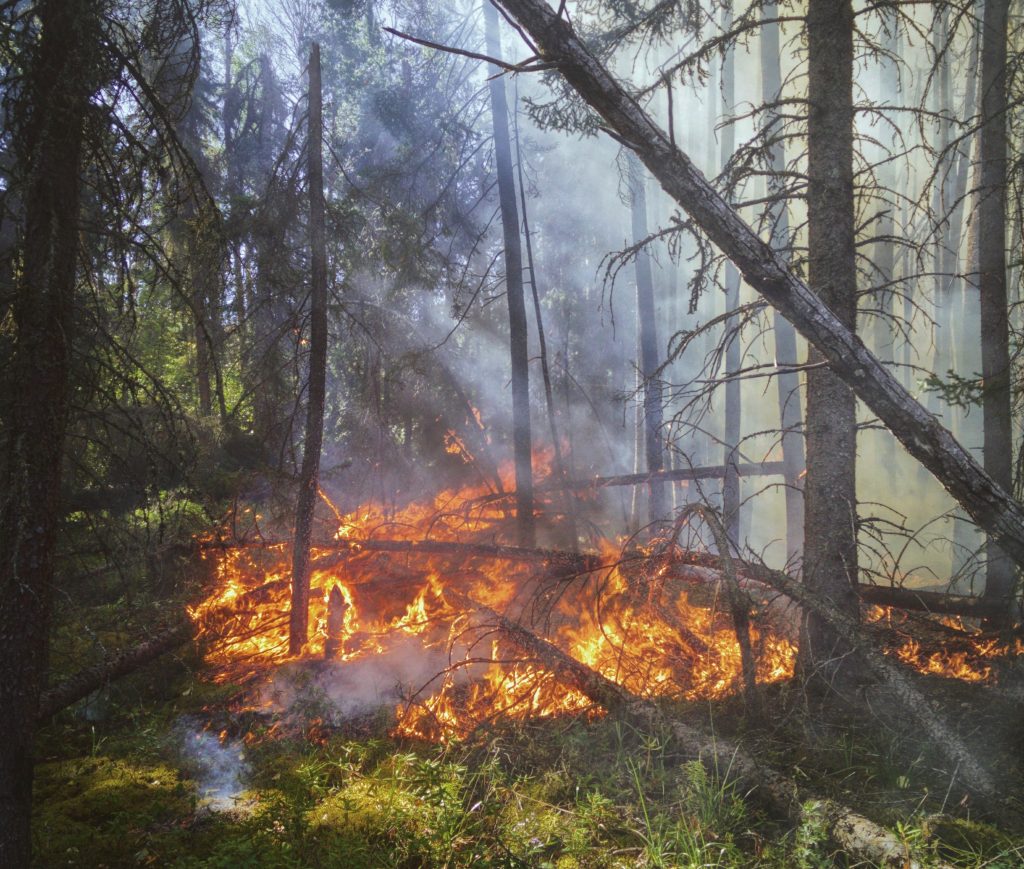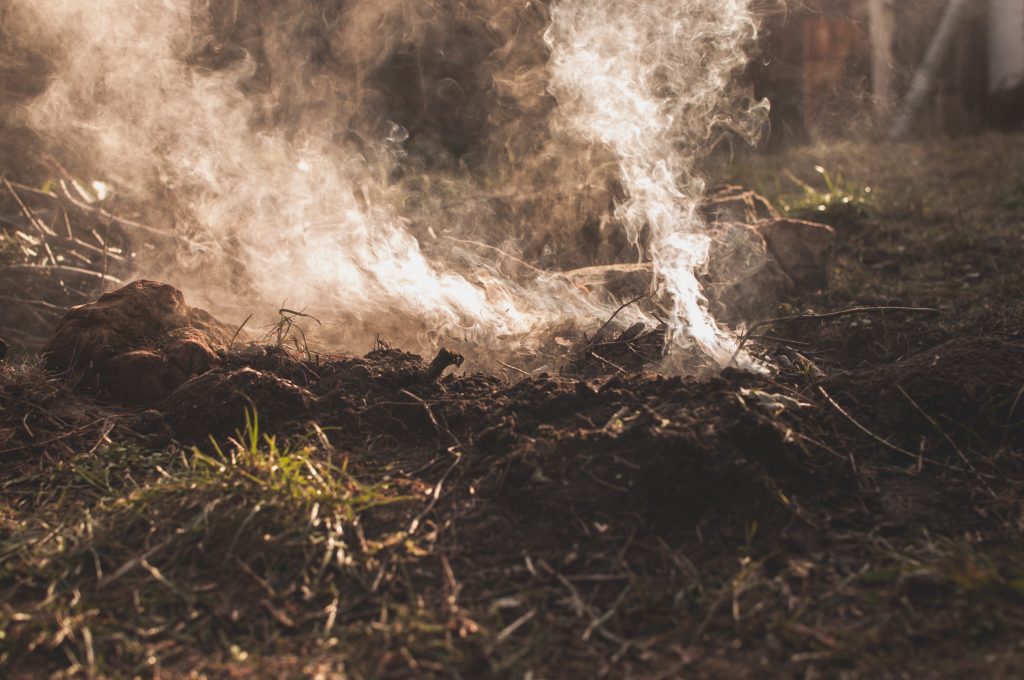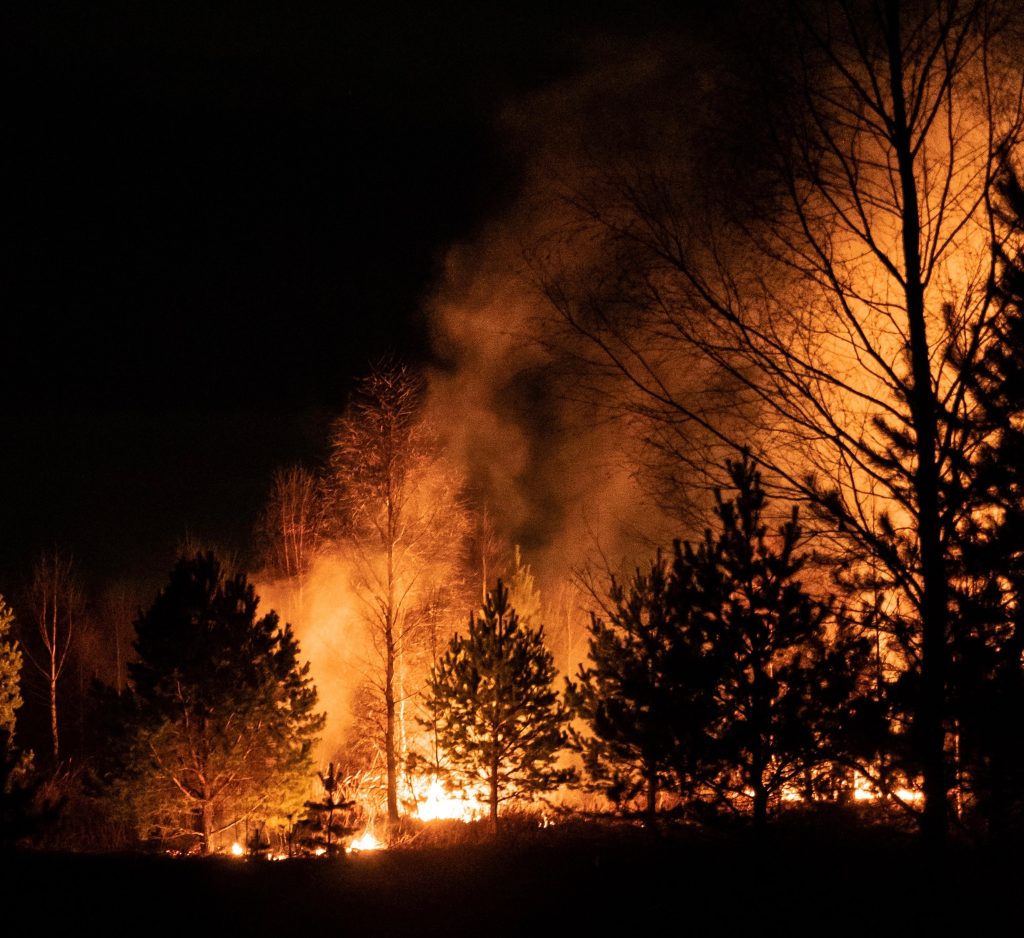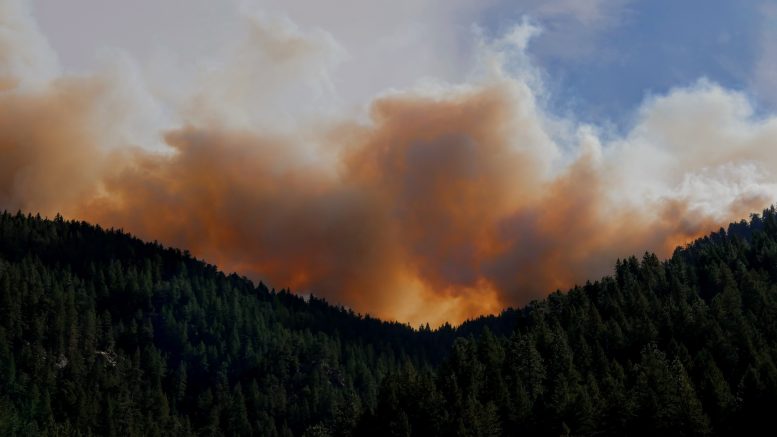By Howard Hardee
Ken Jordan calls it “spotting smokes,” and it’s an easy job when the mountain air is clear: “Sometimes, it’s second nature to spot a smoke without even looking for it.”
White, gray or bluish, woodsmoke typically stands out clearly against the dark backdrop of alpine forest, he says, and his peripheral vision has been trained for decades to catch it. Black smoke likely indicates something human-made—a house, car or something else containing oil—is burning, which is alarming but also easy to spot; “I’ve only seen that once or twice.”
Jordan, 74, is engaged in his 38th wildfire season of spotting smokes rising in wispy tendrils from the canopy of Lassen National Forest—the first sign of a potential disaster. A one-person wildfire-detection system, he’s the lone U.S. Forest Service staffer at the Colby Mountain fire lookout, a mile-high outpost on the border of Butte and Tehama counties with a sweeping view of some 250,000 acres of mountainous terrain from Lassen Volcanic National Park to the floor of the Sacramento Valley.
On a fairly clear mid-July morning on Colby Mountain, with a red flag warning issued by Cal Fire due to dry conditions and high winds, Jordan patrolled the platform and pointed out the highlights of the spectacular 360-degree vista. Mount Lassen loomed majestically on the horizon due north. The rocky and rugged Ishi Wilderness stretched to the east, with the Sacramento Valley beyond mostly obscured by smog. Jordan identified Humboldt Summit; the headwaters of Butte Creek; Forest Ranch and Cohasset in the distance; and finally his main charges to the south, the small mountain communities of Butte Meadows and Jonesville.
With the exception of bald spots from logging clear-cuts and a burn scar along a ridge above Butte Meadows and Jonesville—a sliver of the nearly 1 million acres touched by last summer’s disastrous Dixie Fire—the forest visible from the platform was dense, vast and, if anything, overstocked with fuel thanks to decades of fire suppression.
“Smokey Bear’s message was too effective,” Jordan said of the U.S. Forest Service’s famous public education campaign that falsely suggested wildfires were both unnatural and entirely within human control. “There haven’t been enough fires for the forest to burn as nature intended.”
Indeed, some burns are beneficial. Jordan pointed again to the ridgeline where wildland firefighters stopped the Dixie Fire by a back-burn and dozier line cut high on the ridge. He believes the effort saved Butte Meadows and Jonesville. His own report also helped alert residents of that fast-approaching fire, and he got on the radio to help fire engine drivers navigate back roads and reach the critical ridge.
Longtime Butte Meadows resident Barbara Mann first came to her family cabin in 1936 as a 6-month-old girl. A founding member of Butte Meadows-Jonesville Community Association who was involved in building the community’s volunteer-run firehouse, she credits residents with banding together during crises; they’ve been known to take shovels and picks to cut fire lines to save each other’s homes. But she believes they’re all still standing because of Jordan’s watchful eye.
“If we hadn’t had Ken Jordan at Colby Mountain all these years, I don’t think we would exist today as a community,” she said. “He’s an educated, credentialed and on-top-of-everything type person. He can even see my wood stove in the morning, if you can believe it—he sees the puff of smoke. He is so familiar with the terrain and who lives on the terrain.”
Way of life (saving)

Contrary to the idea that there’s nothing left to burn in Butte and surrounding counties following the devastating Dixie and Camp fires, Jordan doesn’t hesitate to say “there is plenty left to burn.”
Conditions are “worse than ever” thanks to the two-decades-long megadrought in the American West that has turned vegetation into tinder, Jordan said. And many of the steep and heavily forested areas surrounding Butte Meadows, Forest Ranch and Cohasset have been untouched by wildfire for roughly a century, according to the ArcGIS Living Atlas of the World, an online mapping tool that shows California fire perimeters dating to 1878.
Special places are at risk, including such historic gems as the Jonesville Hotel, the Bambi Inn and the old Diamond Match Company camp. Also dotted throughout the woods are many century-old cabins and more recent constructions that closely resemble mansions, if you ask Jordan. Despite wildfires being a natural element of the landscape, he said, the reality is that today there is simply too much at stake to let them burn unchecked.
Jordan typically works six days a week, benefiting from locals who bring him fresh milk and cookies and other essentials. During periods of extreme fire danger, he’ll work 14 days in a row, from 8 a.m. to 8 p.m., before taking mandatory time off. Nobody watches the forest when he’s away.
“People are nervous when I’m not up here,” said Jordan, a Butte Meadows resident himself. “When I’m home and not watching, even I don’t like it. It’s a disaster waiting to happen.”
Jordan’s life has revolved around spotting smokes from the Colby Mountain fire lookout since he first ascended the 43 steps to the top platform in the spring of 1985.
From the beginning, he’s been in awe of the surrounding landscape and the tower itself, built in 1912. He ranks a fire lookout behind only Smokey Bear as the definitive icon of the U.S. Forest Service, and the Colby Mountain lookout is special to him personally.
“It’s been a nice refuge for me,” Jordan said. “I always told myself if I had a job where I needed to wear a tie, I was really screwing up. And it’s turned into more than just a job. It’s a way of life.”
He subscribes to magazines for fire lookout enthusiasts and gleefully shares photos of unique structures from around the country. Jordan even met his late wife, Cheryl, while she was visiting Colby Mountain in 2000. They spent much of their time together spotting smokes and staying at the lookout, which includes 14-by-14-foot living quarters with a bed, electric refrigerator and gas stove.
“She was a good lookout, too,” Jordan said. “She could see smokes even before I did.”
There’s a public-education component to his role. He welcomes visitors to the Colby Mountain Fire Lookout and has given many presentations for residents in Butte Meadows and Jonesville. He’s often invited to family gatherings, too.
“We in the community appreciate him,” Mann said. “He makes a lot of suggestions about how we can be better prepared—‘You need gas, you need food, you need a way to communicate with your family.’
“I really can’t say enough about the coverage he has provided for Butte Meadows and Jonesville.”
Critical observations

Jordan loves the sense of immersion he gets at the lookout. Stargazing from the platform is “magnificent,” he said. “Sometimes it’s so clear, you can almost read by the starlight.”
After sunset, the valley floor glows with city lights. The dark areas he used to observe in the 1980s have been illuminated by an unbroken string of lights along Highway 99 from Chico to Red Bluff. “And it’s been glowing brighter since the Camp Fire,” he said of the valley’s post-disaster population boom.
With more people has come noticeably more air pollution, Jordan said. The clearest views are typically early in the morning, before smog rolls up from the southern Sacramento Valley. Over the years, his view has steadily become more obscured, ever-earlier in the summer.
No matter the visibility, Jordan uses analog methods to site fires, using an apparatus known as the Osborne Fire Finder—a specialized alidade mounted on a 360-degree steel ring—to roughly pinpoint their locations on a map. Then he relays the coordinates to Forest Service stations in Susanville or Oroville, depending on which is closer to the newly sparked fire.
“My job is to see it quickly and get them moving,” he said. “Once a reconnaissance plane spots it, my job is done.”
Jordan has reported hundreds of fires since 1985. He often gets asked whether he’s ever prevented a major one. It’s impossible to say for sure, but he almost certainly has.
“If you stop it at an acre, you never know what it might have grown into,” he said. “I’ve committed myself to Jonesville and Butte Meadows and Cohasset and the Ishi Wilderness. The only fire that has put people in jeopardy was the Dixie Fire. I’m proud that none of the fires that threatened those communities have come from the area I’m watching.”
He was already off for the season when the Camp Fire started on Nov. 8, 2018, but his presence at the lookout wouldn’t have changed anything: The Paradise Ridge is out of his sight line, he said, and the fire’s speed was too extreme for a report to have made a difference.
The greatest risk of wildfire comes from lightning strikes, he said. Lightning has struck close enough to shake the tower on several occasions, and Jordan recalls eerie times when his hair would stand on end from the highly charged atmosphere, but the tower itself has never been struck. Just in case, he has a “lightning stool” designed to prevent him from being electrocuted during a storm.
Shift in sentinels

Jordan claims that still nothing beats the human eye at detecting newly sparked fires, an assertion echoed by other lookouts. “Cameras are virtually worthless for initial detection,” he said. Nonetheless, the number of active fire lookouts in the U.S. has dwindled from thousands to hundreds in recent decades as fire agencies across the country have turned more to aircraft, forest cameras and citizen reports to detect burgeoning blazes.
In California, only 198 of California’s 625 fire lookout towers are still standing, and only about 50 of those are staffed, according to the Forest Fire Lookout Association.
That trend may be reversing somewhat, as the state of Pennsylvania recently rebuilt 16 fire lookouts, and people living in wildland-urban interfaces are increasingly appreciative of having eyes in the sky. But Jordan still views the fire lookout as a structure standing halfway in the past: “I assume, one day, lookouts will be replaced by drones or something like that.”
For now, Jordan remains a critical watchman in the mountains of Butte County. And the fire season has been starting earlier and running later than ever before. Typically, he’s on duty from before Memorial Day to the end of October. This year, his first day at the lookout was on May 12—his earliest-ever start date.
This is also his first full season since 2000 that he is spotting smokes alone. Cheryl died from lung cancer last May. During her time in hospice care, she urged Jordan to return to the lookout as soon as he could, knowing how important the place was for her husband. He was back on duty less than two weeks after her death.
“It was good to focus my attention away from my grief,” he said. “I’m still working through it.”
Cheryl’s cremains are in a wooden urn engraved with a forest scene, complete with an outline of the fire lookout. Only recently has Jordan started feeling OK about leaving them at home while he’s keeping watch.
Last summer, Jordan was evacuated from the lookout for a few weeks during the Dixie Fire, which destroyed the historic fire lookout on Mount Harkness—leaving him as the lone sentinel watching the southern Lassen National Forest. Whereas he used to coordinate with other lookouts in the area to triangulate precisely the location of fires, now he leans heavily on his knowledge of the landscape to approximate the source of smoke and relay the information to responders.
Working alone has other limitations. Jordan, who had hip replacement surgery last year, cannot see into the Deer Creek drainage without descending the lookout’s steps and hustling down a dirt-and-gravel path to the opposite side of a ridge with his binoculars, ready to peer into the area his counterpart on Mount Harkness used to cover.
It’s a daily reminder that he’s one of the last smoke spotters.
“I’m the old man of Lassen Forest now,” he said, scanning the treeline from his vantage on Colby Mountain. “This lookout is more important than ever.”


There are so many fires that errupt nowadays, perhaps be sure to mention that in the “lead” of the article?? This scared me and it took a few paragraphs until the Lassen Mountains, which we already know about was mentioned. Maintain Journalistic Integrity guys!!